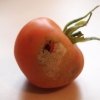How to recognise it
Irregular, ragged holes appear on leaves, buds and petals in the summer (usually between June and September).
The earwig is a yellowish-brown insect up to 25mm in length with a pair of curved pincers and long antennae.
Lifecycle
The earwig females overwinter in soil under stones and debris, alongside 50-100 eggs which she lays in a small chamber in December and January. The eggs hatch in February/March and are fed and tended by the females until they mature and disperse in May/June.
Additional batches of eggs may be laid in summer, producing a second generation of adults in September.
While earwigs do have wings, they mainly disperse by crawling and therefore only travel short distances from their original site.
Why it’s a problem
The earwig can feed on flower petals, leaving them ragged and unsightly. They also feed on the foliage, leaving irregular holes in leaves.
Where you are likely to find it
Attacks shrubs, perennials and annuals. Particularly dahlias, clematis, apricots, peaches and chrysanthemums. Can be found feeding on plants at night (they hide within damaged flowers and fruit during the day).
How to deter it
Maintain good garden hygiene and clear up debris and rubbish to reduce the breeding sites. Digging over can also help destroy existing breeding sites.
If you are moving potted plants indoors for the winter check them thoroughly for infestation in case you transfer the problem to your glasshouse or home.
How to get rid of it
Generally infestations are not serious enough to warrant chemical control, simply shake the plants and destroy (ie tread on!) the earwigs which fall out. This is best done at night when the earwigs are actively feeding.
Placing upturned flower pots filled with straw on canes can provide a perfect day time shelter for earwigs, from which they can be removed and destroyed. They can also be trapped under old sacking, planks or corrugated cardboard placed on soil surfaces and around tree trunks.
If a chemical control if necessary (eg if there is a large infestation near the house) then bendiocarb dust can be used. This is best applied in the evening or at night when the earwigs are most active.
Is it good for anything?!
Earwigs feed on aphids and other small insects considered pests.
Other useful information
While Forficula auricularia is the only species which is really an issue in Britain and Northern Europe, other species may be troublesome in limited areas, particularly in more southern sites.






